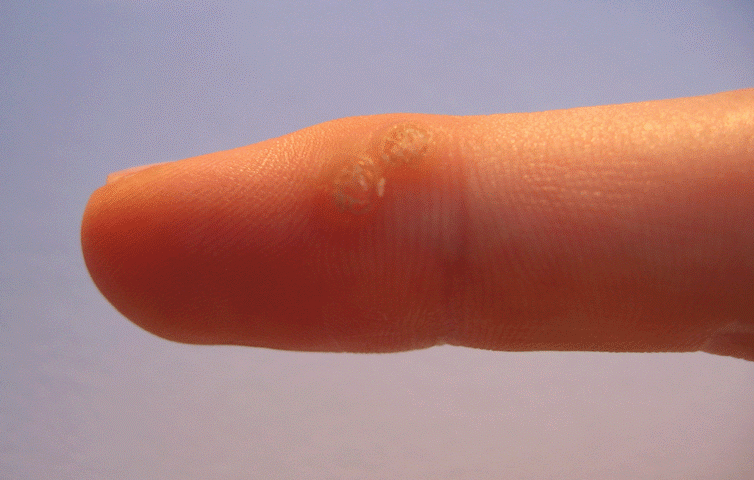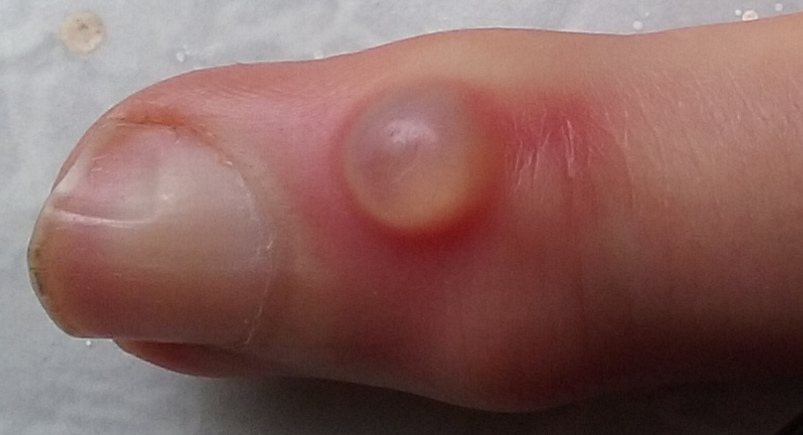Difference Between Wart and Cyst
What is Wart?
Warts are small, hard, rough, not cancerous growths, similar in color to the rest of the skin. The appearance of warts depends on the thickness of the skin and the location on the body. Warts may look like a small cauliflower or a solid blister.
Most warts do not have any symptoms, but they can be painful if appear on the bottom of the feet.
One or many warts may appear at a certain person or certain section of the body. Most

commonly warts occur on the feet and hands but they can also affect other locations, like face, neck, genitalia, etc.
Depending on the affected part of the body and the type of the human papillomavirus (HPV) that causes them, the warts are:
- Butcher’s warts;
- Common warts;
- Genital warts;
- Heck’s disease;
- Flat warts;
- Filiform warts;
- Mosaic warts;
- Periungual wart;
- Plantar warts.
Warts are caused by HPV. The virus enters the body through small skin damages. The risk of infection is higher in people working with meat, using public showers, having a low immune system, etc.
There are 130 types of HPV and each of them infects a few specific parts of the body. Many of the HPV are able to produce warts in the infected area. For example, HPV types 1, 2, 3, 4, 26, 29, etc. produce common warts, HPV types 1, 2, 3, 4, 28, etc. produce plantar warts, HPV types 6, 11, 42, 44, etc. produce anogenital warts, HPV types 3, 10, 28, etc. produce flat warts.
Most types of warts do not need treatment and resolve in months to years. There are different treatments that can speed up the resolution, like the application of salicylic acid and cryotherapy.

What is Cyst?
Cysts are abnormal, closed sac-like structures or capsules, filled with liquid, semisolid, or gaseous material.
Cysts occur within the tissues and can affect any part of the body. Common locations are the ovaries, testes, kidneys, spine, breasts, skin, etc.
Cysts vary in size. Some cysts are microscopic, others can be so big that are able to displace internal organs.
There are many different types of cysts:
- Breast cyst;
- Colloid cyst;
- Dermoid cyst;
- Fibrous cyst;
- Ganglion cyst;
- Hydrocele;
- Nasolabial duct cyst;
- Odontogenic cyst;
- Ovarian cyst;
- Renal cyst;
- Sebaceous cyst.
The common causes of cysts are:
- Infections;
- Genetic conditions;
- Tumors;
- A fault of a developing embryo or in an organ;
- Chronic inflammatory conditions;
- A defect in the cells;
- Blockages of ducts in the body;
- A parasite;
- An injury that breaks a vessel, etc.
The cyst may resolve without treatment or may require medications or surgical removal. Lancing is made in severe cysts.
The signs are different, depending on the type of the cyst. The patient may easily notice an abnormal lump, particularly when the cyst is on the skin or just below it. The cysts of the breasts can also be noticed. Some types of cysts can be detected only via ultrasound, CAT scan, MRI scan, etc. These are cysts in the brain, liver or kidneys.
There are types of cysts that do not have any symptoms. Others, like breast cysts, may be painful. Cysts in the brain can cause a headache.
Difference Between Wart and Cyst
-
Definition
Wart: Warts are small, hard, rough, not cancerous growths, similar in color to the rest of the skin.
Cyst: Cysts are abnormal, closed sac-like structures or capsules, filled with liquid, semisolid, or gaseous material.
-
Appearance
Wart: The appearance of warts depends on the thickness of the skin and their location on the body. Warts are typically small and may look like a small cauliflower or a solid blister.
Cyst: Cysts are closed sac-like structures, variable in size.
-
Affected areas
Wart: Warts can occur on the skin all over the body, but most often they appear on the feet and hands.
Cyst: Cysts can affect any part of the body and occur within the tissues. Common locations are the ovaries, testes, kidneys, spine, breasts, skin, etc.
-
Cause
Wart: HPV types 1, 2, 3, 4, 26, 29, etc. produce common warts, HPV types 1, 2, 3, 4, 28, etc. produce plantar warts, HPV types 6, 11, 42, 44, etc. produce anogenital warts, HPV types 3, 10, 28, etc. produce flat warts.
Cyst: The common causes of cysts are infections, genetic conditions, tumors, a fault of a developing embryo or in an organ, chronic inflammatory conditions, defects in the cells, blockages of ducts in the body, parasites, etc.
-
Treatment
Wart: Treatment of warts may include cryotherapy and salicylic acid.
Cyst: The cyst may require medications or surgical removal. Lancing is made in severe cysts.
-
Symptoms
Wart: Most warts do not have any symptoms. Warts on the bottom of the feet may be painful.
Cyst: There are types of cysts that do not have any symptoms. Others, like breast cysts, may be painful. Cysts in the brain can cause a headache.
-
Types
Wart: Butcher’s warts, common warts, genital warts, Heck’s disease, flat warts, filiform warts, mosaic warts, periungual wart, plantar warts.
Cyst: Breast cyst, colloid cyst, dermoid cyst, fibrous cyst, ganglion cyst, hydrocele, nasolabial duct cyst, odontogenic cyst, ovarian cyst, etc.
Wart Vs. Cyst

Summary of Wart Vs. Cyst:
- Warts are small, hard, rough, not cancerous growths, similar in color to the rest of the skin.
- Cysts are abnormal, closed sac-like structures or capsules, filled with liquid, semisolid, or gaseous material.
- Warts are typically small and may look like a small cauliflower or a solid blister. Cysts are closed sac-like structures, variable in size.
- Warts can occur on the skin all over the body, but most often they appear on the feet and hands. Cysts can affect any part of the body and occur within the tissues. Common locations are the ovaries, testes, kidneys, spine, breasts, skin, etc.
- Warts are caused by HPVs, while the common causes of cysts are infections, genetic conditions, tumors, chronic inflammatory conditions, defects in the cells, blockages of ducts in the body, parasites, etc.
- Both warts and cysts may resolve without treatment or may require treatment. Treatment of warts may include cryotherapy and salicylic acid. The cyst may require medications, surgical removal, or lancing.
- There are types of cysts and warts that do not have any symptoms. Warts on the bottom of the feet or breast cysts may be painful. Cysts in the brain can cause a headache.
- Types of warts are Butcher’s warts, common warts, genital warts, Heck’s disease, flat warts, filiform warts, mosaic warts, periungual wart, plantar warts, etc. Types of cyst are breast cyst, colloid cyst, dermoid cyst, fibrous cyst, ganglion cyst, hydrocele, nasolabial duct cyst, odontogenic cyst, ovarian cyst, etc.
- Difference Between Gallstones and Cholecystitis - September 5, 2021
- Difference Between Constipation and Cramping - August 4, 2021
- Difference Between Whole Genome Sequencing and Microarray - May 6, 2021
Search DifferenceBetween.net :
2 Comments
Leave a Response
References :
[0]Image credit: https://upload.wikimedia.org/wikipedia/en/0/05/Myxoid-cyst-left-index.jpg
[1]Image credit: https://commons.wikimedia.org/wiki/File:Wart_ASA_animated.gif
[2]Cobo, F. Human Papillomavirus Infections. Amsterdam: Elsevier. 2012. Print.
[3]Gibson, C. No More Moles Warts or Skin Tags! Eire: CGI Enterprises LLC. 2010. Kindle Edition.
[4]Wester, K. Arachnoid Cysts. Clinical and Surgical Management. Cambridge: Academic Press. 2017. Print.

Interesting article! I like the info shared by you about warts and cyst. Thanks a lot for sharing the great article.
Thank u..it was helpful.